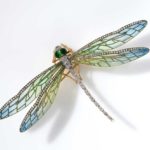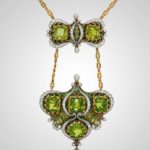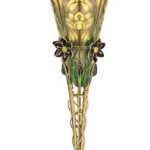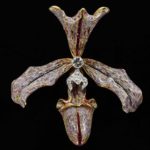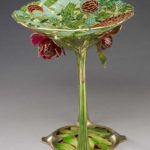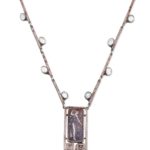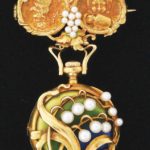Plique-à-jour is a vitreous enamelling technique where the enamel is applied in cells, similar to cloisonné, but with no backing in the final product, so light can shine through the transparent or translucent enamel. It is in effect a miniature version of stained-glass and is considered very challenging technically: high time consumption (up to 4 months per item), with a high failure rate. The technique is similar to that of cloisonné, but using a temporary backing that after firing is dissolved by acid or rubbed away. Reference: Wikipedia.
The technique was very suited to the Art Nouveau style and can be found on many different items from that era.
Below are some examples and price guides of Art Nouveau items using Plique-a-jour techniques including a dragonfly brooch and a Norwegian vase by Marius Hammer.
Conceived as a dazzling dragonfly with delicate plique-à-jour wings, this brooch epitomizes the Art Nouveau style in both fashion and manufacture. With its translucent wings set en tremblant and its sparking rose-cut diamonds, the present jewel catches the light brilliantly. In the enameling technique called plique-à-jour, vitreous enamel is applied to openwork wire cells without a backing, creating the transparent effect of stained glass
Reference: The Metropolitan Museum of Art
Necklace Marcus & Co. (American, 1892–1941) American About 1900
American art nouveau inspired necklace featuring a large pendant with seven peridots, scrolling wirework, filled in with green plique-a-jour enamel, and diamond surrounds in platinum, with pearl accents on a gold chain. Pendant can also be worn as a brooch.
Reference: Museum of Fine Arts Boston
AN ART NOUVEAU PLIQUE-À-JOUR ENAMEL VASE, MARIUS HAMMER, NORWAY, CIRCA 1900 of tapering form, the upper part modelled as a semi-closed flower, in beautiful plique-à-jour enamel representing tulips, lilies, narcissus and fern, the collar and base applied with stylised narcissus in deep plum colour with a yellow centre and gold stamen, maker’s mark, struck MH 930S 22.3cm., 8 3/4in. high
Sold for 12,500 GBP at Sotheby’s in 2019
Hair ornament of gold, enamel, diamonds and rubies in the form of an orchid, made by Philippe Wolfers, Belgium, 1905-7.
Reference: © Victoria and Albert Museum
This remarkable vase, because of its size and complexity, is regarded as an outstanding example of Norwegian Art Nouveau enamel work. The bowl, which is executed in red and green plique-à-jour enamel shows the leaves and flowers of the peony, supported by two stems with leaves and blossoms of the same flower rising from an enameled base.
Reference: The Walters Art Museum
AN ENAMEL AND MOTHER-OF-PEARL NECKLACE, BY FREDERICK JAMES PARTRIDGE, CIRCA 1905 The polychrome enamel plaque depicting the Goddess Diana with a bow and quiver of arrows, within a pink enamel surround terminating with Greek key motifs and a mother-of-pearl drop, to a series of pink enamel baton-links issuing mother-of-pearl accents, closed back settings throughout, mounted in silver, signed Partridge, length 40.5cm, fitted case by Tadema Gallery, London
Sold for £ 4,437 inc. premium at Bonham’s in 2019
